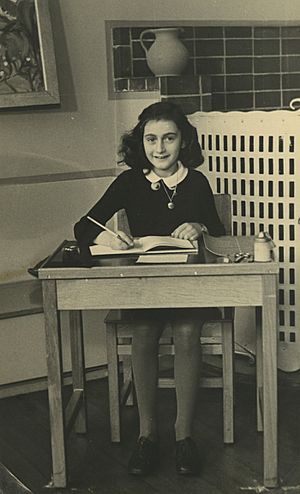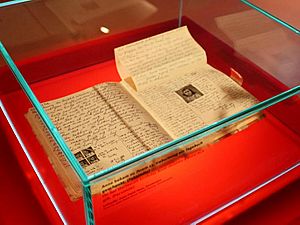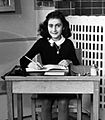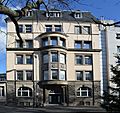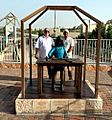Anne Frank facts for kids
Quick facts for kids
Anne Frank
|
|
|---|---|

The last known photograph of Anne taken in May 1942.
|
|
| Born | Annelies or Anneliese Marie Frank 12 June 1929 Frankfurt am Main, Weimar Germany |
| Died | c. February or March 1945 (aged 15) Bergen-Belsen concentration camp, Lower Saxony, Nazi Germany |
| Resting place | Early 1945 Bergen-Belsen concentration camp, Lower Saxony, Nazi Germany |
| Nationality | German from 1929 until 1935 Stateless from 1935 until 1945 |
| Period | 1942 – 1944 |
| Notable works | The Diary of a Young Girl (1947) |
| Relatives | Margot Frank (sister) |
| Signature | |
Annelies or Anneliese Marie Frank, known as Anne Frank (born June 12, 1929 – died around February or March 1945), was a German-born Jewish girl. She became famous after her death when her diary was published. In her diary, she wrote about her life hiding from the Nazis during World War II.
Anne's family moved from Germany to Amsterdam, Netherlands, in 1933. This was the same year the Nazis gained power in Germany. By 1940, the Nazis had taken over the Netherlands. Life became very hard for Jewish people. In July 1942, Anne's family went into hiding. They stayed in secret rooms in her father's office building. After two years, they were found and sent to concentration camps. Anne and her sister, Margot, died from typhus in 1945. Anne's diary is now one of the most widely read books in the world. It is considered a classic in war literature and history.
Early Life
Anne Frank was born on June 12, 1929, in Frankfurt, Germany. She was the second daughter of Otto Frank and Edith Frank-Holländer. Her older sister was Margot Frank. The Frank family was Jewish.
In 1933, the Nazi Party won elections in Frankfurt. They immediately started to treat Jewish people unfairly. The Franks were worried about their safety in Germany. So, Edith and her children moved to Aachen to stay with Edith's mother. Otto Frank moved to Amsterdam to start a business. He found a place for his family to live. The Franks were among 300,000 Jewish people who left Germany between 1933 and 1939.
Otto Frank started working at Opekta Works, a company that sold pectin. He found an apartment on Merwedeplein in Amsterdam. By February 1934, Edith and the children joined him. Anne and Margot started school. Margot went to public school, and Anne went to a Montessori school. Margot liked math, while Anne loved reading and writing. Her friend Hanneli Goslar remembered that Anne often wrote, even when she was young. Anne tried to keep her writing a secret. Margot and Anne had different personalities. Margot was quiet and thoughtful. Anne was brave, energetic, and friendly.
In 1938, Otto Frank started another company called Pectacon. It sold herbs, salts, and spices for making sausages. Hermann van Pels, a Jewish butcher, worked there. In 1939, Edith's mother came to live with the Franks. She stayed with them until she died in January 1942.
In May 1940, Germany invaded the Netherlands. The government began making strict rules against Jewish people. Anne and Margot were doing well in school and had many friends. But a new law forced Jewish children to attend only Jewish schools. Otto Frank's companies earned less money. It became harder for the family to live.
Before Hiding
In July 1942, Margot Frank received an order to report to a work camp. Otto Frank decided it was time for his family to hide. They would hide in secret rooms above his company's office. This building was on the Prinsengracht, a street next to one of Amsterdam's canals. Some of his trusted employees would help them. The order for Margot made them go into hiding a few weeks earlier than planned.
Hiding
Anne's father, Otto Frank, wanted to protect his family from the Nazis. He spoke to some of his employees. One of them was a young woman named Miep Gies. Otto told her he needed help. He planned to turn the top floor of his business into a secret hiding place. They called it "The Secret Annex". Miep and others agreed to help them keep their secret. They also brought them food.
In 1942, the Frank family moved into the Secret Annex. The Van Pels family and a dentist named Fritz Pfeffer also joined them. They planned to stay hidden until the war ended. They hoped the war would be over soon, but it lasted much longer. They spent about two and a half years in hiding. They could never go outside into the sunshine. During the day, they had to be very quiet. The business continued downstairs, and not all workers knew about the secret hiding place.
A few months before they went into hiding, Anne received a diary for her birthday. She named her diary "Kitty". In it, she wrote about everything happening to her and her family. Anne was a young girl, but she wrote beautifully. She wrote about her friends, her parents, and her feelings. Anne soon had a strong dream: she wanted to be a writer. She hoped to write a book that everyone would read.
After two and a half years in hiding, the family was discovered. A thief was caught in the building. To avoid jail, he told the Nazis about the Franks. Nazi soldiers came to the Secret Annex. They sent the Franks and the others to a concentration camp. Miep Gies found Anne's diary. She put it in a drawer to keep it safe. She hoped Anne would return so she could give it back.
Sadly, Anne did not return. Otto Frank was the only one in his family who survived.
Death
Janny Brandes-Brilleslijper, a Holocaust survivor, saw Anne in the Bergen-Belsen concentration camp in early 1945. Anne was very thin and wrapped in a single blanket. Anne told Janny that she had thrown away her clothes because of lice. Anne also asked Janny to help her sister Margot, who was very sick. Janny promised to find clothes for Anne and help Margot. She gave Anne some bread.
Three days later, Janny learned that both Margot and Anne had died. She said Margot fell from her bed and died quickly from shock. The next day, Anne fell into a coma while sleeping and died soon after. Anne likely died from typhus fever. Janny and her sister Lientje buried Margot and Anne in a mass grave.
Researchers from the Anne Frank House believe Anne died around February 1945. This was about two months before the camp was freed.
Diary
Miep Gies was with Otto Frank when he learned that his daughters had died. She knew Anne would never come back for her diary. Miep took the diary from the drawer and gave it to Otto Frank. People who knew Anne read the diary. They told Otto Frank that he should publish it. Anne had wanted to be a famous writer. Now, people could read her book. They would also learn about the hard times Jewish people faced during the war. They would also learn about the kind people who helped them.
Otto had Anne's diary printed. It became one of the most widely read books in the world. It has been printed in over 60 languages. People everywhere have read and enjoyed this true story. Today, you can visit the house in Amsterdam where Anne Frank and her family hid. You can also see the original diary she wrote.
Images for kids
-
A partial reconstruction of the barracks in the Westerbork transit camp where Anne Frank was housed from August to September 1944
-
Memorial for Margot and Anne Frank at the former Bergen-Belsen site
-
Het Achterhuis (literally, "the back house"), the first Dutch edition of Anne Frank's diary, published in 1947, later translated into English as The Diary of a Young Girl
-
Statue of Anne Frank made by Pieter d'Hont (1959) in the Janskerkhof, Utrecht
See also
 In Spanish: Ana Frank para niños
In Spanish: Ana Frank para niños


